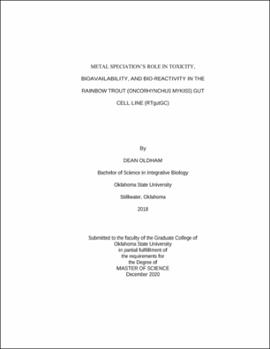| dc.description.abstract | The bioavailability of metal complexes is poorly understood. To evaluate the bioavailability and toxicity of neutral, and charged metal complexes, as well as free metal ions, Visual Minteq, a chemical equilibrium model, was used to design different exposure media to allow the formation of a variety of metal species. Two non-essential (silver and cadmium) and two essential (copper and zinc) metals were selected. The rainbow trout (Oncorhynchus mykiss) gut cell line (RTgutGC) was used to investigate the bioavailability, bioreactivity and toxicity of different metal species. Dose response curves were calculated using a multiple endpoint cytotoxicity assay which measures simultaneously metabolic activity, cell membrane and lysosomal integrity. Bioavailability of different metal species was evaluated by exposing cells to an identical non-toxic dose of metal. Intracellular metal was then measured by ICP-MS. Bioreactivity was measured by quantification of mRNA levels of genes that respond to metal toxicity, such as metallothionein (MT), oxidative stress such as glutathione reductase (GR) and zinc homeostasis such as Zinc Transporter 1 (ZnT1). Speciation calculations showed variation of metal species depending on anionic media composition. Silver and cadmium showed affinity for chloride, copper for phosphate, and zinc remained primarily in its free ionic form. All metals complexed with cysteine avidly reducing metal toxicity, bioavailability and bioreactivity. Silver and copper toxicity were not affected by extracellular metal speciation, whereas cadmium and zinc toxicity were reduced by chloride complexation. Moreover, reduction of calcium in the medium increased toxicity and bioreactivity of cadmium and zinc. The bioavailability of non-essential metals was affected by media composition, while essential metals were tightly controlled by the cell in most media. For silver, low chloride reduced bioavailability while for cadmium bioavailability was increased by the presence of bicarbonate in the media. Non-essential metals induced increased GR and MT mRNA levels, zinc induced MT in all media excluding the control and cysteine media and copper induced MT only in the low chloride medium. ZnT1 was induced by cadmium in low-chloride media, by zinc in low-chloride low-calcium and by cadmium and copper in the no phosphate bicarbonate media. Overall, this study demonstrates that speciation alone is not sufficient to explain metal toxicity, and that many factors play a role in metal-cell interactions. | |
